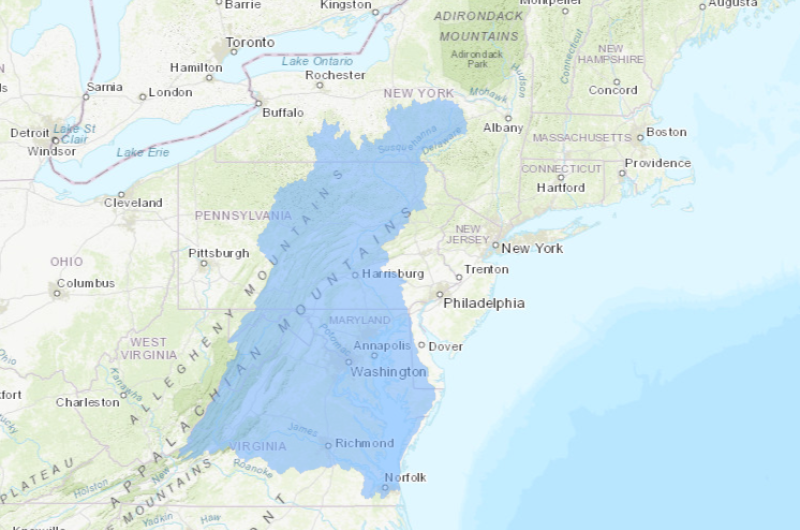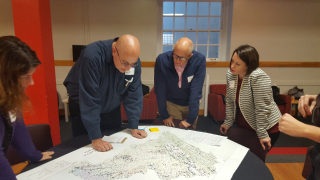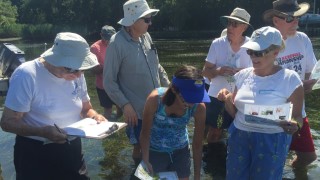Collaborating Around the Chesapeake Bay Region
The Bohemia River is tucked up in the corner of the Chesapeake Bay. Formed by the Great Bohemia Creek in Delaware and the Little Bohemia Creek in Maryland, the Bohemia River merges with the Elk River before flowing into the Chesapeake Bay. Since 2015, Chuck Foster has made the Bohemia River his whole life. Foster has a laundry list of things he does as a founding member of Friends of the Bohemia.
Friends of the Bohemia, headquartered in Chesapeake City, Maryland, is involved in countless events: coastal clean-ups, school programs in Maryland and Delaware, rain barrel workshops, paddle tours of the river, Bay grass monitoring and more. But the cornerstone of Foster’s work is the group’s water quality monitoring and the report card it has put together for the past three years, which displays the trends and issues for the Bohemia River and surrounding landscape. Foster says, “We’ve put out a report based on 2016, ‘17 and ‘18 data. We see it as an educational piece for the public. It also gives people recommendations of concrete things they can do to help clean water.”
Beyond its annual report card, Friends of the Bohemia has been doing something else it sees as important – participating in the Chesapeake Monitoring Cooperative (CMC) and adding data to the Chesapeake Data Explorer website. Through the CMC, volunteers from groups around the 64,000-square-mile Chesapeake watershed are sharing their data and getting it into the hands of the federal Environmental Protection Agency’s (EPA) Chesapeake Bay Program.
The Chesapeake Bay Program has a goal of a cleaner Chesapeake and focuses on the status and trends of water quality throughout the Bay region. The CMC started because the Bay Program was aware of and impressed by the small groups that were already active in the Bay and committed to collecting sound water quality data. EPA saw community groups as a huge opportunity for learning more about the health of the Chesapeake and the streams and rivers flowing into it.
Friends of the Bohemia is one of more than 80 community groups in the CMC. From upstate New York to Roanoke, Virginia, the CMC supports volunteer monitoring programs by training monitors to collect standardized chemical and biological water quality data, helping groups start brand-new monitoring programs or teaching volunteers how to interpret and effectively communicate the data they collect.
 The 64,000-square-mile Chesapeake watershed is shown in blue.
The 64,000-square-mile Chesapeake watershed is shown in blue.
Shared Data Makes All the Difference
The CMC is a collaborative composed of the Alliance for the Chesapeake Bay, the University of Maryland Center for Environmental Science, the Alliance for Aquatic Resource Monitoring (ALLARM) at Dickinson College and the Izaak Walton League of America. These organizations act as the service providers for smaller water-oriented groups. Funded by EPA’s Chesapeake Bay Program since 2015, the mission of the CMC is to work with diverse partners to collect and share new and existing water quality data and develop a comprehensive understanding of the health of the Chesapeake Bay.
The CMC includes many different monitoring groups, each with their own goals and programs, and brings them under one umbrella. Often, citizen monitoring groups have come to monitor local waterways for their own reasons and started their programs at different times with different guidance. This leads to groups working right next to one another, all using slightly different methods to test water quality. The aim and success of the CMC has been getting these groups to use the same standards and methods, which immediately makes their data more comparable and therefore more useful. In addition to standardizing methods, centralizing data also becomes a powerful tool.
Groups in Virginia were already on track to have comparable useful data, because they had, for quite some time, worked with the CMC service providers. They participated for years conducting macroinvertebrate monitoring with the League and the Virginia Save Our Streams program or have collected monthly chemical water quality data through the Alliance for the Chesapeake Bay’s RiverTrends program.
The Chesapeake Data Explorer database enables volunteer groups to elevate their data to a platform where the Chesapeake Bay Program and states can easily access and utilize the information. Not only can these groups be confident that their data is being considered by decision makers, but they can also see it alongside other data being collected throughout the Chesapeake.
The Value of the Volunteer Data
Dedicated volunteers throughout the region are not monitoring just for monitoring’s sake. Like Foster with Friends of the Bohemia, all the monitoring groups want their data to make a difference and improve water quality.
The Chesapeake Bay is the largest estuary (a place where fresh water and salt water mix) in America. It’s an incredible natural resource, an economic driver and a recreational mecca for millions. But the Bay is in trouble and it has been for decades. In 2010, after 25 years of voluntary efforts to reduce pollution fell far short of goals, EPA adopted the first-ever "pollution diet" for an estuary. This plan sets clear and enforceable targets for reducing nitrogen, phosphorus and other pollution and marshals federal funding and other resources to help states, localities and landowners achieve the targets.
With the plan in place, it became even more important to track progress toward the goals. That requires establishing a baseline and the ability to gather data over time. In the Bay, we need to do this work not only in a few streams or in one state, but also across a region covering nearly 64,000 square miles. Although states, localities, EPA and local groups had water quality data from many locations, they lacked data across large areas, data collection was infrequent, and coordinating between different governments and agencies was an added challenge. Moreover, state and local governments do not have the staff or budgets to directly monitor water quality on the scale required.
That’s where volunteers come in. "We see it as this great opportunity to fill in gaps in our data from around the watershed,” says Peter Tango of the U.S. Geological Survey and the Chesapeake Bay monitoring coordinator at the Chesapeake Bay Program. “Contributions from monitoring by volunteers has provided valuable insights into living resource abundance and distribution that would not be available otherwise. Various programs have had volunteer collaborations that have spanned 50 to 100 years.”
“The CMC is already successful. The feedback in the community is increased stewardship, starting to get that data used by [state and county water quality] managers, and policymakers, that help tell the story of where good habitat and living resources may be and where they need more support and evaluate how we are doing in terms of Bay health over time,” says Tango.
Back on the Bohemia, Foster is also feeling good about the CMC. “The CMC has been a real boon to us. No one else seemed to have one place to share this kind of information and you guys came along and absolutely filled that void. And we can all put that data in and know that someone will use it. It’s awesome.”
He’s happy to be involved beyond just sharing their data. For example, the CMC helped Friends of the Bohemia diversify its monitoring program with the addition of macroinvertebrate sampling. “And then the macro piece of it – we’re so happy the Izaak Walton League was able to train us in that and get us started. Macroinvertebrate sampling is a great way for us to engage people because it’s fun!”
Tango and his colleagues at the Chesapeake Bay Program value and trust volunteer data the CMC provides. “As a scientist, I have to trust and verify all data before I use it. In this case, the CMC has put in place a process for the verification of data integrity, and that structure raises the value of data brought into the Data Explorer for a variety of uses."
HEALING A SICK CHESAPEAKE BAY
The Chesapeake Bay, a valued estuary known for its fishing and blue crabs, faces its fair share of pollution issues.
Since the Chesapeake Bay Watershed, or area of land that drains into the Bay, is 64,000 square miles, there are many potential sources of pollution, from farmland to cities and everywhere in between. Excess nitrogen and phosphorus feed algal blooms that block sunlight to underwater grasses and contribute to the formation of dead zones, areas in the Bay and its tidal waters without enough oxygen.
With low oxygen and without the habitat of the Bay grasses, the Bay cannot support the fish and oysters that are essential to the Bay’s ecology and the economy. The oysters, blue crabs and fish that come from the Bay amount to a multi-million-dollar industry with tens of thousands of jobs and decades of history and culture. Tourism and boating recreation also contribute significantly to the region’s economy. Pollution of the Chesapeake is an ecological and economic issue; the fisheries and recreational activities around the Bay are totally dependent on a healthy ecosystem. There is no easy fix to a pollution problem like this: there is no one targeted source, so coordination and cooperation between all the jurisdictions in the watershed is necessary to improve water quality.
Although the Chesapeake Bay Program had worked for decades on restoration projects to improve the Bay, they were not succeeding because the water quality remained poor. The Bay was facing high pollution levels from agricultural runoff, wastewater treatment and urban land use. In 2010, EPA set a Total Maximum Daily Load (TMDL) to reduce nitrogen, phosphorus and sediment load in the Bay by 25 percent, 24 percent and 20 percent, respectively. This TMDL is the largest of its kind, requiring the cooperation and buy-in from New York, Pennsylvania, Delaware, Maryland, Virginia, West Virginia and Washington D.C.
First in the Nation Agreement for Using Volunteer Data
The value of the CMC is bigger than just one federal program being interested in volunteer water quality data. In 2018, the CMC worked with the Chesapeake Bay Program and the states in the region to adopt an unprecedented Memorandum of Understanding (MOU) that recognizes the value of volunteer-collected data and ensures state and federal agencies consider CMC data when making decisions around water quality issues. Although there are a few examples of individual states agreeing to consider volunteer monitoring data in decision-making, this MOU is the first that utilizes this approach on a regional scale.
Based on this agreement, Virginia, Maryland, and Washington D.C. are using the data in the Chesapeake Data Explorer when they perform their annual review of water quality in their jurisdictions. They find value in the fact that all the volunteer-collected data is in a single portal and they can easily parse out how data was collected and the level of scientific rigor used.
This MOU is not only important for the Chesapeake. The agreement to use and consider volunteer data can also serve as a model for other states and regions across the country.
What Does Any of This Mean to an Ike?
 Chesapeake Monitoring Cooperative partners gather around a watershed map to prioritize locations for monitoring efforts.
Chesapeake Monitoring Cooperative partners gather around a watershed map to prioritize locations for monitoring efforts.
Since the beginning of this project in 2015, the League has been an integral part of the CMC. We support the team of service providers, helping to coordinate the other organizations’ involvement and the entire project. Early on, the League spearheaded the effort to learn about the data collected throughout the six-state region. League staff conducted months of meetings and outreach with state agencies and existing monitoring groups to understand the water quality data needed in specific areas and identify volunteer groups that might be able to fill those needs. It was also the first opportunity for government staff and volunteer groups to learn about the CMC and our goals. The League’s efforts helped people begin to trust the program and want to participate in the project. This initial outreach culminated in a comprehensive report that, among other things, documents where state and local governments prioritize new or expanded volunteer monitoring. This provides the foundation for the CMC to mobilize and develop volunteer capacity in ways that directly contribute to detecting and reducing pollution and eventually restoring the Bay.
If you’re a member of the League and you live in the region, you can be part of the CMC too! If you participate in Virginia Save Our Streams, you are already part of the CMC! If you live in one of the other Bay states, the League can train you to test water quality by identifying macroinvertebrates and other aquatic life. Our partners at ALLARM or the Alliance for the Chesapeake Bay can also provide training in chemical monitoring. The results of this monitoring can then influence the decision-making process of state agencies and the Chesapeake Bay Program.
 Friends of the Bohemia volunteers identify and map out Bay grasses.
Friends of the Bohemia volunteers identify and map out Bay grasses.
If you live outside of the Chesapeake region, consider how a model like the CMC could work in your part of the country. By having agreed-upon methods and standards used by community groups throughout a region, it makes it easier for volunteers to get monitoring programs started and to utilize comparable data on a larger geographic scale.
Foster thinks so too. “The more we can standardize what everyone is doing in the Bay, the better. It has been so helpful to have common standard operating procedures [for monitoring and]… a menu [of monitoring options] to choose from. It has heightened my awareness of what to do for more rigor and to make what we are doing more valid.”
What’s Next for the CMC?
“I see the CMC in a new phase of growth and maturity,” says Tango. “When I think of the seed of the idea that was planted a decade ago and see where we are now with the dedicated support of an outstanding team, and the trainings through workshops across the watershed on data collection, data analysis, and the development of the quality assurance processes – in my eyes it’s a great success.”
The CMC has only just begun. New groups want training all the time in water quality and macroinvertebrate monitoring methods. Groups that have existed for a long time are coming forward after seeing the success to get their historical data into the Chesapeake Data Explorer.
Chuck Foster is happy to see it. “The CMC is a wonderful thing. It’s spread the word all around about how we can partner and collaborate to achieve our goal of clean water and a healthy environment.”
Learn more about the Chesapeake Bay